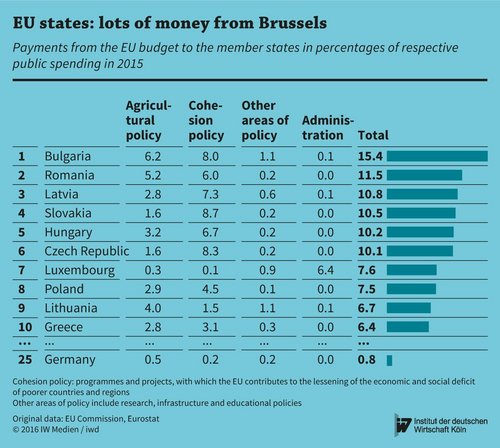The European Union spends a lot of money year for year on, for example, supporting poorer member states and regions, or to promote agricultural, research and educational policy. Compared to national public spending, payments from the EU budget are sometimes astonishing.

Paymaster Brussels
In 2015, 130 billion euros flowed from the EU budget into the 28 member states. France received the most money with 14.5 billion euros, and Spain received 13.7 billion euros. Germany was fifth amongst recipient countries with 11 billion euros.
These are, however, just the gross figures from Brussels – they have to be offset against the contributions that the individual countries make to the EU budget. All in all, Germany and France belong to the net payers: in 2015 they contributed respectively 14.3 billion euros and 5.5 billion euros more to the EU budget than they got back.
Among the net recipients in 2015 were Poland with 9.5 billion euros from Brussels and Spain with 4.5 billion euros.
A separate consideration of the gross figures is useful, however, to gauge the significance of the money from Brussels for the individual countries. When EU payments are regarded in relation to the national public expenditure, it becomes clear that it is above all the middle and eastern European countries in the union that profit most (see chart):
At the top of the ranking is Bulgaria – in 2015 it was granted 2.7 billion euros from Brussels, which corresponds to more than 15 per cent of its public expenditure.
Right behind Bulgaria are Romania and Latvia. Luxembourg makes for an exception, as a large sum of EU payments goes to the EU institutions residing there.
The high payments to the middle and eastern European countries can be traced back primarily to expenditure for economic and social cohesion. Using these means, the EU is attempting to lessen the gap between the poorer countries and regions and the wealthier member states.
In Bulgaria, for example, the aims of the “Science and Education for Smart Growth” programme, which will run from 2014 until 2020, include strengthening the research infrastructure and improving the quality of education in schools and universities.
EU funds play a relatively lesser role for the older EU members – in nine countries the funds reach a maximum of 1.5 per cent of public spending. Payments are mostly in connection with the financing of the common agricultural policy; in France, this accounts for more than 60 per cent of all payments from Brussels, a good 70 per cent in Finland, and more than 80 per cent in Ireland.
More on the topic
Not so Different?: Dependency of the German and Italian Industry on China Intermediate Inputs
On average the German and Italian industry display a very similar intermediate input dependence on China, whether accounting for domestic inputs or not.
IW
China’s Trade Surplus – Implications for the World and for Europe
China’s merchandise trade surplus has reached an all-time high and is likely to rise further. A key driver appears to be a policy push to further bolster Chinese domestic manufacturing production, implying the danger of significant overcapacities.
IW